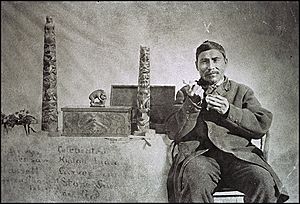Charles Edenshaw facts for kids
Quick facts for kids
Charles Edenshaw
|
|
|---|---|

Edenshaw and carvings
|
|
| Born | 1839 |
| Died | 1920 (aged 80–81) |
| Nationality | Haida |
| Occupation | Artist |
| Known for |
|
Charles Edenshaw (born around 1839–died 1920) was a famous Haida artist. He came from Haida Gwaii, which is a group of islands off the coast of British Columbia, Canada.
Edenshaw was known for his amazing skill in many art forms. He created beautiful carvings from wood and a special black stone called argillite. He also made stunning jewellery and paintings. His art was very original and told stories in new ways. Even so, he always followed the traditional rules of Haida art, known as formline art. In 1902, a famous collector named Charles F. Newcombe said Edenshaw was "the best carver in wood and stone now living."
Charles Edenshaw's Early Life
Charles Edenshaw was born around 1839 in the Haida village of Skidegate. This village is on Haida Gwaii, an island group near British Columbia, Canada. His Haida name was Da.a xiigang, which means "Noise in the Housepit."
His family was very important in their community. They were able to hold many potlatch ceremonies. These were big gatherings where families showed their wealth and shared gifts. As a baby, Charles was given other special names, like "They Gave Ten Potlatches for Him." During these ceremonies, he received tattoos of animals like eagles, seawolves, and frogs. Charles's father was a skilled canoe maker. He likely taught Charles how to carve wood when he was young.
When Charles was about 18, he moved to the village of Masset on Haida Gwaii. He went to live with his uncle, Albert Edward Edenshaw. His uncle was also a very talented artist. He taught Charles many skills, including how to work with metal, make jewellery, and carve wood.
In 1885, Charles and his wife, K’woiy∂ng, were baptized and took the names Charles and Isabella. They had eleven children, but only four lived to be adults. Today, many of Charles Edenshaw's great-grandchildren are also famous artists, carrying on his family's artistic legacy.
Charles Edenshaw's Art and Career
Charles Edenshaw started carving argillite and silver when he was about 14 years old. While other Haida artists had carved argillite before, Charles was one of the first to use precious metals like silver and gold.
By the time he got married, Charles was earning a living from his art. His busiest time was between 1880 and 1910. He often worked in a shed in his backyard. In the winter, he would sometimes travel to Victoria, British Columbia to work. During the summer, he and his family traveled to different places, like Juneau, Alaska. There, he would create and sell his artwork. His wife, Isabella, would also make and sell baskets.
Charles made many pieces for the Haida people, such as carved wooden benches and tombstones. He also made art to sell to people from outside the community. These included poles, chests, bowls, and platters made from wood and argillite. He also created wooden masks, rattles, and model canoes. He even painted designs on baskets and hats that Isabella made.
His artwork was collected by important museums, like the American Museum of Natural History. He also helped anthropologists, who are scientists who study human societies and cultures.
In 1927, the National Gallery of Canada held an art show. This was the first time Charles Edenshaw's work was officially recognized as "fine art." He was seen as being as important as other famous Canadian artists like Emily Carr. Today, you can find many of Charles Edenshaw's amazing artworks in major museums around the world.
Images for kids


